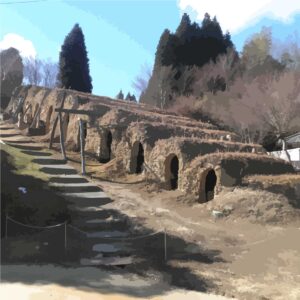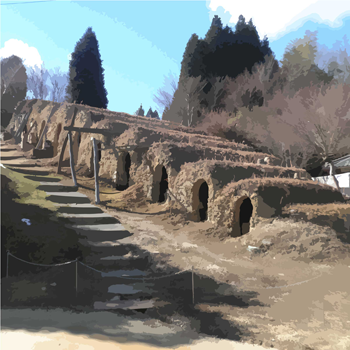
This is the most common type of kiln used in Japan since ancient times. It consists of several rectangular chambers on a sloping surface, with the front chamber lower and the rear chamber higher, and the kiln is gradually built up the slope. The smallest chamber at the front end is called the firing chamber, the next is called the domoki-ma, and the next is called the waste chamber, where the gas burned in the firing chamber is burned more effectively, and products are put in from the next chamber and fired. The gas from the first chamber preheats the second and third chambers, and so on, until it flows out of the last chamber. Since the chamber is built on a sloping surface, each chamber naturally acts as a chimney to improve ventilation. The firebrands that pass through each chamber exit from the lower end of the kiln chamber, follow the upper ceiling to the rear, and enter the next chamber from the lower part. In other words, it is an inverted flame system. Firing the first chamber requires a considerable amount of time and fuel, but the second and subsequent chambers are preheated, so the amount of fuel can be gradually reduced to shorten the firing time, and firing can be done semi-continuously. Wood is used as fuel, first in the fire opening, and later through the wood inserts on both sides of each chamber. The wood is thrown in through holes with a diameter of only 16 or 17 centimeters, and the technique of arranging the wood in order from the center of the long chamber to the two ends of the chamber requires skill. In many regions, many potters fire one kiln at a time because the kiln capacity is so large. Before the Meiji Restoration, climbing kilns tended to become larger and larger due to restrictions on kiln stock, but after the Meiji Restoration, economic conditions became more active, and the number of kiln chambers decreased because it was inconvenient to fire a large group of kilns. However, the size of kiln chambers expanded remarkably after the Meiji period. Kilns before climbing kilns were cellar kilns, and climbing kilns were introduced to the Owari and Mino (Aichi and Gifu prefectures) regions from Hizen Karatsu in the early Edo period. The small kiln was introduced to various regions of Japan and gave birth to various schools, such as Kyo-gama, Marugama, Kogama, Hongyogama, Aizu-gama, and so on. According to a legend and the results of a survey of kiln sites in the area, the climbing kiln was introduced from Karatsu during the Keicho (1596-1615) to Kan’ei (1624-44) period.



